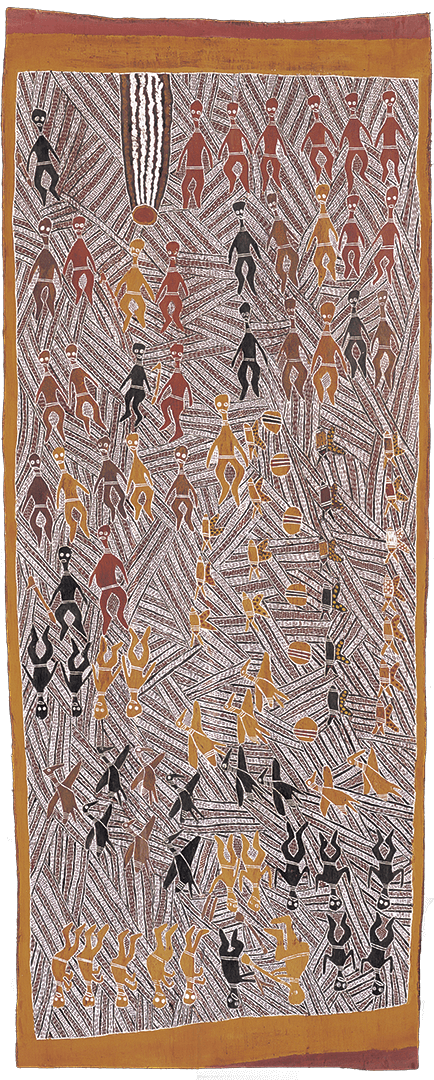We acknowledge the Traditional Owners of the land on which the Queensland Art Gallery | Gallery of Modern Art stands and recognise the creative contribution First Australians make to the art and culture of this country.

Larrtjanga Ganambarr / Ngaymil/Dathiwuy people / Australia c.1932–2000 / Balirlira and the Macassans c.1958 / Natural pigments on bark (Eucalyptus tetrodonta) /158 x 64.5cm / Purchased 2003 with funds from the Queensland Art Gallery Foundation Appeal and the Queensland Art Gallery Foundation Grant / Collection: Queensland Art Gallery | Gallery of Modern Art / © Larrtjanga Ganambarr
Larrtjanga GanambarrBalirlira and the Macassans c.1958
Not Currently on Display
This bark painting documents more than 500 years of contact between the Yolngu people of north-east Arnhem Land and Macassan fishermen from South Sulawesi, Indonesia.
The Macassans travelled to Marege, as they called the northern shores of Australia, on the early monsoonal winds to gather the prized trepang (sea slug), a lucrative product which they traded with the Chinese.
The reference to a specific spirt man, Balirlira, and the richly expressive episodic story describing his interaction with the Macassans, gives us an insight into the depth of the Macassans’ influence on Yolngu art and culture.
Larrtjanga Ganambarr, from Arnhem Bay in north-east Arnhem Land, was one of a group of young Dhuwa artists who learned to paint from renowned Rirratjingu artist Mawalan Marika (Indigenous people of north-east Arnhem Land belong to one of two basic divisions, or moieties, called Dhuwa and Yirritja). Ganambarr’s work often represents waterholes where the Djang’kawu — the major creative beings for the people of the Dhuwa moiety — spent time.
His paintings are characterised by ‘meticulous bands of cross-hatching which represent . . . the dense surface vegetation of the waterholes and swamps, interspersed with lines of footprints marking the pathways of animals and birds’.1
Ganambarr was one of eight artists who created Yalangbara c.1960 — an early version of the magnificent Church panels 1962–63, made by the same eight artists to hang on the sides of the altar in the local church at Yirrkala.
Endnotes:
1. Sylvia Kleinert and Margo Neale (eds.), The Oxford Companion to Aboriginal Art and Culture, Oxford University Press, Melbourne, 2000, p.591.
Discussion Questions
This bark painting depicts the trade of sea cucumbers by the Yolngu people of Arnhem Land and Macassan fisherman from Sulawesi. What types of items are traded between Australia and Indonesia today? How are they traded?
Classroom Activities
Consider the perspective used in this painting. How does it provide insight into the trade activity that was taking place? Choose your own media to create a sense of perspective with regards to the current Australian trade activities.